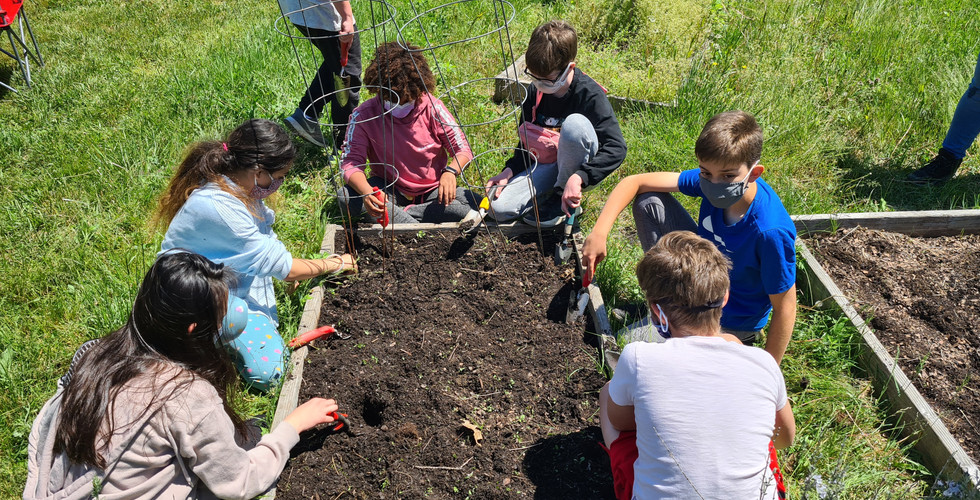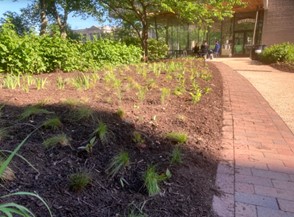Where Do Our Nursery Plants Go?

At our plant nursery, we currently have approximately 1,000 plants. Year-round, we work to make sure that our plants stay healthy and are ready to bloom when their flowering season comes around. But what do we do with all of our plants? Through multiple partnerships and programs, we are able to put our plants towards a variety of hands-on learning experiences, local retail customers, and installations. Below are just a few answers to where our plants go.
Hands-on Learning Programs
Students from Belmont Charter and The Philadelphia School helping in our vegetable gardens.
This summer, our nursery has hosted several hands-on learning programs. We have had students from Belmont Charter and The Philadelphia School who came to learn about the importance of native plants, ecology and the environment. Among routine nursery activities such as watering and potting, one lesson that the students really enjoyed was through a scavenger hunt. They learned how the different physical characteristics of the plants define what family or species they belong to and thus, can help identify them. We focused on noting a few basic characteristics, such as if the plant has a square or rounded stem, an opposite or alternate leaf arrangement, and if there is a strong scent when the leaves are crushed. With these characteristics in mind, students found examples from a variety of plant species.

In addition, we taught the students how to look for relationships between plants that grow on the site and plants that we use for food. For instance, the students noticed grasses that have joints, related to corn, and even plants in the rose family that are related to strawberries. Through exploring the site and hands-on experiences, the students were able to study plants and understand how to identify them.

Saylor Grove Wetland
One avenue for our nursery plants is local retail. One of our partners is Saylor Grove Wetland, a demonstration project in the Wissahickon Watershed that combines stormwater management with ecological restoration. This site does very important stormwater management, as surface water from above the site in Germantown is heavily polluted. This water runoff is directed into Saylor Grove Wetland when it rains and gradually sinks into the ground to get filtered. The site is also important in reducing the amount of really dry and really wet periods, by using the water in the wetland to even those occurrences out, functioning like a sponge.
An important part of its surrounding neighborhood, Saylor Grove Wetland is a nice park with a lot of Pennsylvania native plants, including trees, shrubs and herbaceous varieties. Friends of Saylor Grove Wetland host events as part of Love Your Park Week a couple of times a year. One of these events is a native plant sale that as partners of Saylor Grove Wetland, we bring our nursery plants to. We are able to raise consciousness about using native plants and find a home for many at these special events.

Weavers Way
Another of our wonderful partners for local retail is Weavers Way. Weavers Way is a Philadelphian consumer-owned food cooperative that has been around since 1972. With a focus on finding locally grown and produced food, they have many important programs, such as sustainability and education. Starting out from a little row house in Mt. Airy, they have grown a lot and even expanded into an Ambler location in Montgomery County. Through our partnership with them, we agreed that it would be a great location to give customers a native plant alternative for their individual gardens. This retail setting has been a great opportunity for locals to buy our native plants and learn about the advantages of using them.
Our set-up at Weavers Way in 2020.
Sister Cities Park
Perhaps our most complex plant destination would be our landscape designs and installations. One installation location we have is Sister Cities Park, located by Logan Square. The park is a great family-friendly Center City location, with a café and water features. We worked with the Center City District, which is a non-profit that supports improvements in Center City. They approached us to incorporate native plants into the very formal garden spaces at Sister Cities. We planned a revision to redevelop one of the garden spaces outside of the café that is about 600 square feet. We used a complement of Pennsylvanian native meadow plants in order to recreate a meadow-like scene that park visitors can enjoy.
Part of our installation outside of Sister Cities Café during the first week.
Glen Foerd

The program students working on clearing out the site to prepare for planting.
Our most recent installation was at Glen Foerd. This location is a historic mansion and estate located right near the edge of Poquessing Creek as it flows into the Delaware. Through a connection with Glen Foerd, we wanted to help be a partner in the water-oriented student programming that was taking place there throughout the summer. The students were learning about boat skills and kayaking, as well as the environment, water and watersheds. With Glen Foerd staff, we planned a native planting with the students to enhance their site. Near the mansion is a retention basin that was historically used for the on-site water system. Then, a tennis court was put on top of that, carving out a large rectangular area. Today, it is an empty lawn that the owners wanted to naturalize.

We designed a planting that reflected the ecology of the site, but also gave a chance for the students participating in their program to do something active and hands-on. More specifically, we wanted to design something that highlighted different complements of plants that you would be more likely to see in wet areas, dry areas, shady areas and sunny areas. In the dry/shady region, the students planted Blue Wood Aster (Aster cordifolius). In the dry/sunny region, the students planted more of the grasses, such as Little Bluestem (Schizachyrium scoparium) and Switchgrass (Panicum virgatum). In the wet/shady region, the students planted Blue Flag Iris (Iris versicolor), Jacob’s Ladder (Polemonium caeruleum), Pink Turtlehead (Chelone lyonii) and Swamp Milkweed (Asclepias incarnata). Finally, in the wet/sunny region, the students planted Rosemallow (Hibiscus moscheutos). The students really enjoyed learning about the different plants we brought, where they like to live and what they will look like when they grow. After clearing the site of weeds, the students finished with about 400 square feet of planting on a slope leading into the tennis lawn. It was a very big project and a great opportunity to combine hands-on experience with our native plant installations.

Home
Regardless of if our plants are used at the nursery for hands-on programs, put into other retail locations to be bought by shoppers in a store, or planted directly into the ground at an installation, they are in their natural environment. Our native plants are accustomed to the Pennsylvania area and climate. Thus, they need much less care and attention than exotic plants that may be selling in stores today. Our natives do not need as much water, can go dormant during our cold winters and are naturally integrated into the habitat they are planted in. This means that they are less likely to be invasive and can thrive in the natural ecosystem of Pennsylvania, with the surrounding plants, insects and animals. Whether you see our plants at one of our partnered retail locations, installed in the ground nearby, or you visit our nursery and take home some for your own yard, our native plants are home here.


















Comments